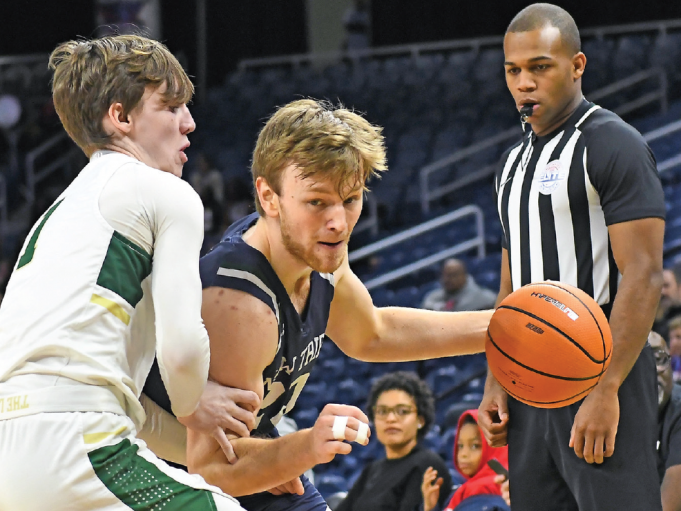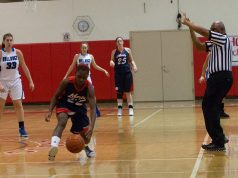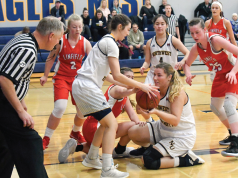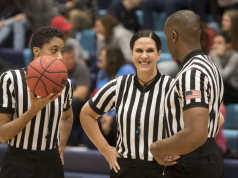The center official on a three-person crew is the straw that stirs the drink. When “C” is active, things go more smoothly and games are apt to be better controlled and officiated; without that effort, more bad things can happen because coverage tends to lapse into a sort of hybrid, substandard two-person mechanic. Here’s a little history to illustrate what I mean.
Probably half of Referee readers aren’t old enough to remember the days when college and professional basketball was worked with only two officials. Games were fast then, too, and the best officials were the whippet-quick souls who could keep ahead of the action. They moved frequently within their coverage areas to get the best look possible, wherever the ball was located. One was focusing on the point of attack, while the other surveyed the rest. The problem developed, as the game became more physical, that two sets of eyes couldn’t see it all; physicality became roughness, with the threat of more injuries. The advent of the three-point shot made it even tougher. It begat more perimeter play, spreading the area of activity to be observed even more. The net result was play becoming more chaotic, which negated athleticism.
In response, three-person mechanics were devised to have the new center position monitor the activity off-ball, while two officials controlled things better on-ball. Some constituencies — like stingy owners and athletic directors — resisted the three-person trend but eventually acquiesced. I wrote an article in the early 2000s statistically demonstrating that adding an official did have an effect in reducing foul counts by reducing out-of-control play. I also predicted it would extend the careers of officials by reducing their physical demands. It would also allow them to bring along newer officials more proactively, working with two veterans instead of one.
What I see today, as I look around, is those prophecies coming true — but with consequences. We have too many badly out-of-shape officials working, regardless of age. They take advantage of the three-person system to wait up near the top of the arc like a taxi at the airport, hopelessly out of position to oversee play. The center never gets down below the free-throw line, while the trail strays only inches over the division line. They use these “head starts” to compensate for their lack of mobility; in transition, they can’t keep ahead of a fast break, causing even more problems.
Second, from these vantage points, they often have less ability to cover player-to-player interactions than they could in two-person mechanics — they have less onus to work around the play.
Third, if watching the tip of their nose is any indication, they still watch the ball more than they observe the four to six players on the weak side of the floor. The net result is games taking a turn for the worse in terms of physicality. The expectation in three-person mechanics is an official will have less distance to cover to get in correct position to monitor play; what we see instead is some officials moving even less.
The center’s job, done properly, is to facilitate the lead and trail getting to the thick of the action and then enabling the freedom of motion the rules committees are demanding we permit. Clinicians I’ve heard will tell you that about 60 percent of foul calls should come from the center. That will happen when “C” is monitoring secondary defenders, helping out on presses, engaged in weakside rebounding and managing weakside drives to the bucket. If the center’s percentage is noticeably less than that, night in and night out, the position is probably too much of a passenger and the crew is suffering.
Let’s look at the four areas just mentioned and illustrate how an active “C” makes things better:
Monitoring secondary defenders
If the ball position has been established on the left wing, for example, with a guard, shooter and post player on that side, the trail and lead should be over there, too. That leaves a second guard and another forward on the right side of the rim line. The center must move down to somewhere below the free-throw line in this case for best result. If a shot comes from the strong side, the center has the weakside rebounding. If a screen is set through the lane, the center has it. If the ball is quickly switched to the weakside guard, “C” is well-positioned to cover the one-on-one matchup that results. If a weakside defender moves over to help on-ball, the lead/trail might have trouble officiating that and the center must help. A good crew calls the center’s actions “help”; a weak one sees it as “poaching.” Which crew is yours?
Helping on presses
Once a basket is made, the active center’s first breath will be taken watching the second-to-last defender head up the court — or not. The new trail can handle one defender applying pressure to the inbounds pass. The second-to-last defender hanging around tells one and all that a press may be on and where the best place to cover it will be. In any press, the center’s role is crucial. If this defender stays roughly at or below the arc, then “C” is watching for freedom of motion fouls on either team during the inbounds pass. The center is also ready to help out on-ball if it comes to his or her side. If more of a half-court press is set up, it’s unreasonable to expect the new trail to catch a backcourt violation if also covering ball pressure; “C” should help. Then, as the ball finds its way up the court, “C” should move with the ball until able to settle into frontcourt coverage. Even if there’s no press and everyone just sets off to the other end, the active center will look in toward the court for any transition antics. The antithesis to all these healthy behaviors by “C” is an official simply dropping his or her head and heading to the other end to wait for whatever is happening.
Engaging in weakside rebounding
On any try for goal, the center and trail will be sharing responsibility for signaling a threepointer (or not). Unfortunately, for the passive center, this morphs into watching the flight of the ball if the shot comes from trail. In my experience, more rebounding fouls come from the side of the lane opposite the shot, possibly because rebounders figure no one is watching them — and the ball-watching center seems to prove it. Having said this, the first time an active center ignores the ball, watches the players and bangs the first one plowing over an opponent underneath the rim, life changes. The episode will become a topic of conversation in both huddles during the first timeout.
Managing weakside drives to the hole
We touched on it above, but often enough the offense loads the strong side as a ruse. They want to isolate a weakside player to take a quick reverse pass and drive against a favorable matchup. There’s no time for the crew to rotate strongside, but that doesn’t matter. In this case, it’s the center’s (or trail’s) job to follow the ball all the way into a potential crash and be prepared to make the call on the defender. Done properly, the center pinches in on the play for a better look and helps sell it. Done passively, “C” stays put, a crash ensues and is followed by some hostility but no whistle. These four examples aren’t an all-encompassing list of things to do; they simply illustrate the underlying point: Some officials treat what we have the center doing as a form of interference or meddling with the game. They believe their mutual focus should be on-ball and that they needlessly add to the foul count if the center butts in like this. The paradox is that an active center actually helps reduce the foul count if the pattern is established early that there are no hiding places. Try it some time.
Teams more often adjust better to a tightly called game, helped by an active center, than a loosely called one. The “C” is usually the lynchpin of an effective three-person crew. Insinuate the “C” into your management of the game and things typically go better for everyone.
Tim Sloan, Davenport, Iowa, is a high school football, basketball and volleyball official, and former college football and soccer official.
What's Your Call? Leave a Comment:
Note: This article is archival in nature. Rules, interpretations, mechanics, philosophies and other information may or may not be correct for the current year.
This article is the copyright of ©Referee Enterprises, Inc., and may not be republished in whole or in part online, in print or in any capacity without expressed written permission from Referee. The article is made available for educational use by individuals.


















